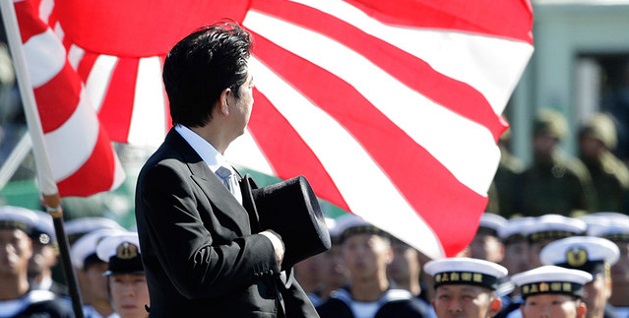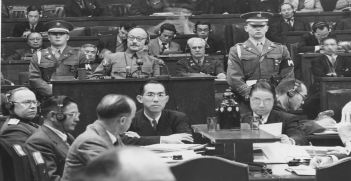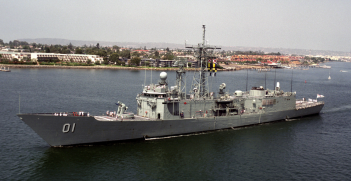Great Powers in 2018: Japan’s Regional Offensive

As the United States retreats, Japan is assuming the mantle of leadership in the Asia-Pacific region.
With President Trump’s pivot away from Asia and disengagement from Asia-Pacific regionalism in trade, it is not only China but also Japan that is moving quickly to fill the vacuum in regional leadership. The combination of uncertainty over America’s policy commitments and China’s regional ambitions has generated a strong incentive for Japan’s Prime Minister Abe to launch an economic, diplomatic and strategic offensive of his own in order to exercise more influence over the regional order.
Not only does Abe project a strong diplomatic presence both regionally and globally but he is also clearly crafting a complex engagement policy that involves building trade networks, strengthening diplomatic ties and creating binding multilateral frameworks.
Indeed, Japan’s regional offensive engages practically all facets of Japan’s external policies: trade, aid, investment, diplomacy, defence and security. The principal motivation is the Abe administration’s desire for Japan to assume a leadership role in the region as well as a growing insecurity about whether the United States has the will and capability to defend shared regional interests. Japan’s move to adopt a proactive leadership role will also be one of the most important factors blocking the development of a Sino-centric regional order.
On trade, America’s retreat into economic nationalism and trade protectionism, including its withdrawal from the Trans-Pacific Partnership (TPP) and hard tactics in dealing with China has allowed the Japanese leadership to illuminate an alternative path to free and fair trade. Japan aims to take the multilateral route to bring the 11-nation Comprehensive and Progressive Trans-Pacific Partnership (CPTPP) to a successful conclusion and spearhead negotiations for a successful conclusion to the 16-nation Regional Comprehensive Economic Partnership (RCEP).
Japan has also become a prime mover in attempting to reshape the security architecture in Indo-Pacific Asia by focussing on balancing China with a strategy that promotes multifaceted cooperation amongst Japan, India, the United States and Australia aimed at realising a “free and open Indo-Pacific” (FOIP). This strategy will be adopted as part of Japan’s basic policy in the new 2018 National Defence Program Guidelines (NDPG), which are currently under review and which will drive the expansion in Japanese military capabilities over the next five years.
The strategy was originally conceived in Abe’s first administration in 2006-07 and primarily manifested in the Quadrilateral Security Dialogue (Quad I). It was later revived in the very early days of Abe’s second administration with a proposal to create “Asia’s Democratic Security Diamond” designed “to protect the stability of the region…through more security cooperation with Australia, India and the United States.”
As a foundational security framework, it laid the basis for strengthening cooperation amongst the four member nations in security and other spheres including Quad II – the Quadrilateral Security Dialogue relaunched in 2017.
In his second administration, Abe has continued to promote the Indo-Pacific concept as the structural centrepiece of his regional strategy, with Trump enthusiastically bandwagoning on the idea in 2017. His administration later explicitly implemented this as a strategic principle in policy and rhetoric in relation to Chinese incursions into the vicinity of the Japan’s Senkaku Islands in the East China Sea and at APEC meetings in both 2017and 2018.
The idea of a “Quad” is also being replicated in other spheres such as infrastructure development, with Japan, Australia, the United States and New Zealand teaming up in a combined pushback against China in Papua New Guinea. This involves the four nations jointly funding a project to increase electricity supply to 70 percent of the population in the developing nation by 2030.
In fact Abe’s vision of a “free and open Indo Pacific” is sufficiently flexible to provide an overarching strategic principle to guide a range of Japanese security and other initiatives. For example, it now provides the mutually agreed goal of a strengthened US-Japan alliance while underpinning closer Japanese military ties with India. Japan also supports a US-Japan bilateral initiative to create a “peaceful, prosperous and free Indo-Pacific” by strengthening their partnership in areas such as energy, infrastructure and maritime security, and deepening bilateral coordination between Japan and Australia on building a “free and open Indo-Pacific region” and engaging in greater bilateral defence cooperation. Furthermore, at the recent G-20 meeting in Argentina, Japan, the United States and India reached a trilateral agreement on the importance of promoting the “free and open Indo-Pacific” initiative and deepening mutual ties in areas such as maritime security and regional infrastructure investment.
This vision is also shared by other Quad members who are stepping up cooperation and trilateral defence cooperation involving the United States, Japan and Australia, particularly in the maritime domain, with the three nations’ naval forces undertaking a joint minesweeping exercise in Japanese waters for the first time in November 2018. This exercise has been explicitly interpreted as demonstrating trilateral unity in line with the “free and open Indo-Pacific” vision.
The same idea also underpins the formation of a trilateral partnership between Japan, the United States and Australia to mobilise investment in infrastructure development in the Indo-Pacific and to build more robust militaries in Pacific Island states. At the same time, it supports Abe’s promotion of closer ties with Australia and New Zealand in South Pacific affairs, including assisting with capacity building in Pacific island states.
These initiatives are being backed up by the growing strength of Japan’s defence capabilities and regional military posture, including its increasing force projection into the contested South China Sea and into the Indian Ocean.
Aurelia George Mulgan is a Professor at the University of New South Wales, Canberra.
This article is published under a Creative Commons Licence and may be republished with attribution.





